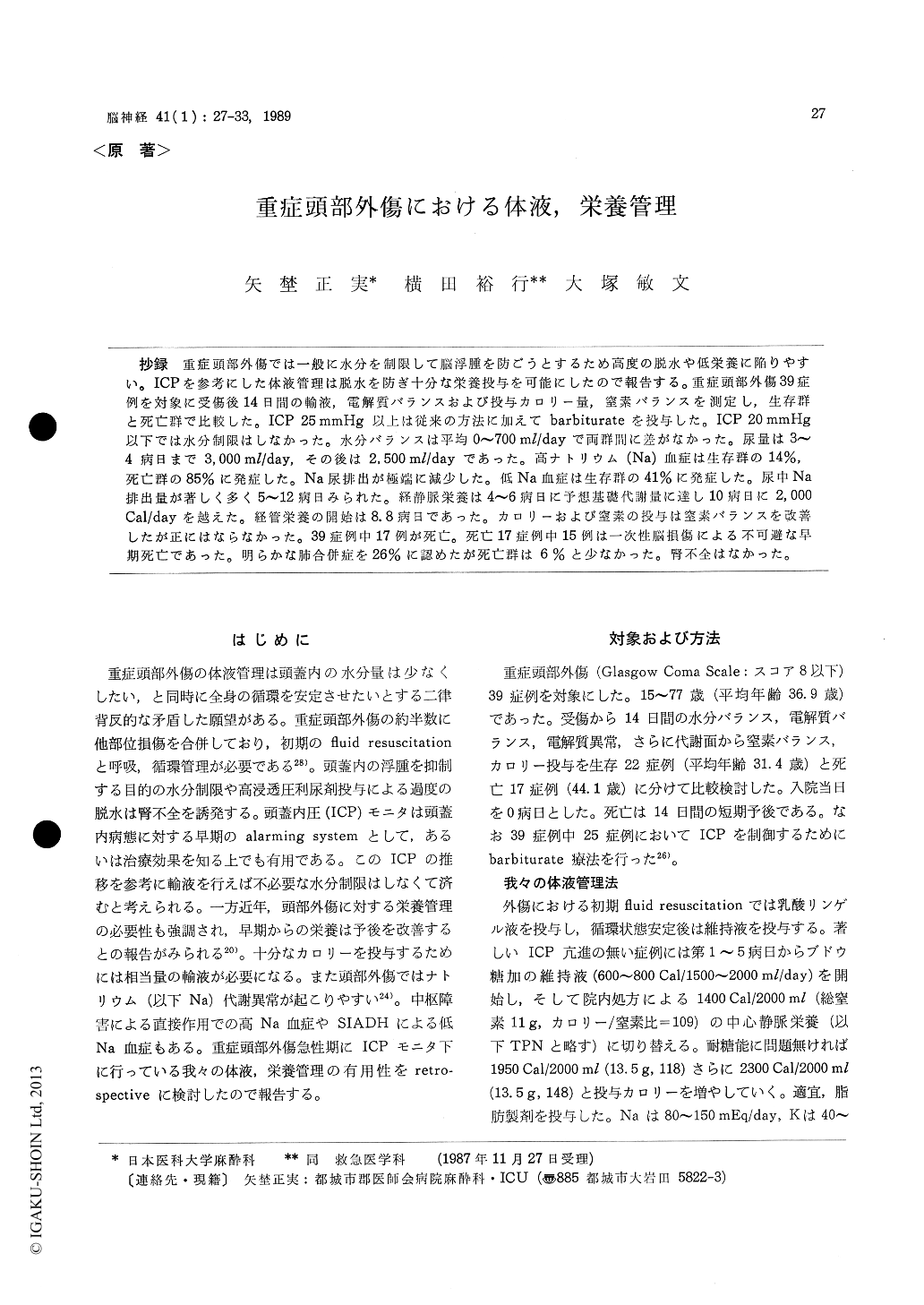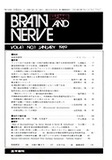Japanese
English
- 有料閲覧
- Abstract 文献概要
- 1ページ目 Look Inside
抄録 重症頭部外傷では一般に水分を制限して脳浮腫を防ごうとするため高度の脱水や低栄養に陥りやすい。ICPを参考にした体液管理は脱水を防ぎ十分な栄養投与を可能にしたので報告する。重症頭部外傷39症例を対象に受傷後14日間の輸液,電解質バランスおよび投与カロリー量,窒素バランスを測定し,生存群と死亡群で比較した。ICP 25mmHg以上は従来の方法に加えてbarbiturateを投与した。ICP 20mmHg以下では水分制限はしなかった。水分バランスは平均0〜700ml/dayで両群間に差がなかった。尿量は3〜4病日まで3,000ml/day,その後は2,500ml/dayであった。高ナトリウム(Na)血症は生存群の14%,死亡群の85%に発症した。Na尿排出が極端に減少した。低Na血症は生存群の41%に発症した。尿中Na排出量が著しく多く5〜12病日みられた。経静脈栄養は4〜6病日に予想基礎代謝量に達し10病日に2,000Cal/dayを越えた。経管栄養の開始は8.8病日であった。カロリーおよび窒素の投与は窒素バランスを改善したが正にはならなかった。39症例中17例が死亡。死亡17症例中15例は一次性脳損傷による不可避な早期死亡であった。明らかな肺合併症を26%に認めたが死亡群は6%と少なかった。腎不全はなかった。
Fluid management, electrolyte balance and nu-tritional support had been examined for 14 days in 39 patients of severe head injury under intracranial pressure (ICP) monitoring. When ICP value ex-ceeded 25 mmHg, barbiturate was administered in addition to the conventional therapy. Restriction of fluid administration should depend upon ICP values. When the ICP value was 20 mmHg or less and basal cisterns or ventricular systems were not obliterated in serial CT scan, fluid administration was not restricted in most patients. Mean urine volume was measured 2500 ml/day and mean water balance was measured about 0 to 700 ml/day with large deviation. Urine output and specific gravi-ty was checked every hour and water balance was evaluated every day. When excess urine output or dehydration was recognized, additional fluid was given to keep within 500 ml/day in water balance. Through the examination, no patients of dehydration nor azotemia were experienced. Out of 39, 22 were survived and 17 were expired. In expired patients, 13 patients was recognized dead or brain death within 72 hours of injury. In two patients (one is suffered from severe brain-stem injured patient with corpus calosal hemor-rhage and another patient with post operativecerebral swelling) cerebral herniation was recog-nized about 72 hour after injury. Remaining 2 patients died after 7 days. Patients with hyper-natremia were recognized 3 (13. 7%) out of 22 survivals, and 14 (82. 4%) out of 17 expired pa-tients. It was recognized more common within 3 days of injury. Hypernatremia more than 160 mEq/l was accounted 5 (29. 4%) in expired patients, but non in survivals. Patients with hyponatremia were recognized 9 (40. 9%) of 22 survivals.
The majority of hyponatremia was recognized between 5 to 12 days after injury. In hypernatre-mia, natrium excretion was severely suppressed. Lowest concentration of urinary natrium was 1 mEq/l and its output was 4 mEq/day. In hypo-natremia, natrium excretion was facilitated. High-est concentration 284 mEq/l, and highest output was measured 843 mEq/day. About 4 to 6 days after injury, mean calorie of total parental nutri-tion reached the predicted basal metabolic rate, and exceeded 2000 Cal/day by 10 days after injury, which was 130 to 150% of predicted basal metabolic rate. Enteral nutrition started 8. 8 days after injury combined with total parental nutri-tion.
As calorie and nitrogen intake increased, nitro-gen output increased, but nitrogen balance amelio-rated. We concluded that ICP monitored is useful for fluid and nutritional management. Nutritio-nal support would ameliorate the nitrogen balance, because nitrogen administration promoted synthe-sized protein and prevented catabolism in severe head injury.

Copyright © 1989, Igaku-Shoin Ltd. All rights reserved.


